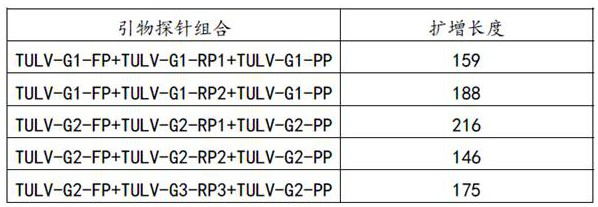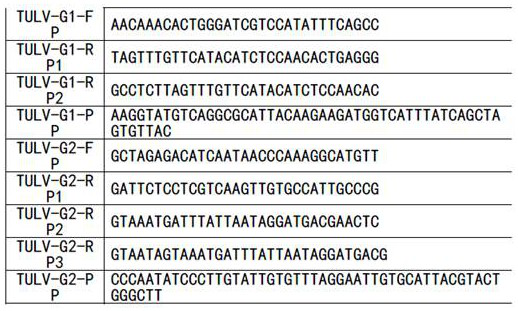RAA primer probe for detecting Talavirus and detection method
A technology of primer probe and detection map, applied in the field of RAA primer probe and detection of Tula virus detection, can solve the problems of high personnel requirements, expensive instruments, long detection time, etc., to reduce detection time, reduce detection cost, The effect of short detection time
- Summary
- Abstract
- Description
- Claims
- Application Information
AI Technical Summary
Problems solved by technology
Method used
Image
Examples
Embodiment 2
[0055] The method for RAA fluorescence method detection JUNV virus, comprises the steps:
[0056] (1) Homogenize the tissue of the sample to be tested, extract the nucleic acid according to the method of extracting RNA from the tissue, and store it at -20°C for later use; if the sample is whole blood, serum, or plasma, use steps such as lysis, magnetic bead enrichment, washing, and elution to extract nucleic acid;
[0057] (2) Turn on the constant temperature fluorescent gene detector RAA-F1620 to preheat, set the reaction parameters, the reaction parameters are set to 39 ° C, and the reaction time: 20min;
[0058] (3) Add 12.7 μL of water to 25 μL of reaction buffer, 2.1 μL of upstream and downstream primers and 0.6 μL of probe at a concentration of 10 μM, mix well, add to RAA fluorescent basic reaction reagent and mix to obtain a reaction master mix;
[0059] (4) Add 2.5 μL of Mg to the cap of the reaction tube 2+ , fully mixing 5 μL of the nucleic acid extraction solution...
Embodiment 3
[0114] Embodiment 3 actual sample detection
[0115] (1) The sequences of primers, probes and negative quality controls are the same as in Example 1.
[0116] (2) Eight clinical samples 1 to 8 in the experiment were provided by Ningbo International Travel Health Care Center;
[0117] (3) Sample extraction method:
[0118] Homogenize tissue samples first, and then extract nucleic acid according to the method of extracting RNA from Tiangen commercialized tissue; extract nucleic acid from serum and plasma by lysing, magnetic bead enrichment, washing, and elution; store at -20°C for later use;
[0119] (4) Implementation method
[0120] Step 1. Prepare reaction solution (prepared according to 10 reactions):
[0121] Draw 250 μL from the reaction buffer and add it to a 1.5mLEP tube prepared in advance, add 167 μL of water, 21 μL of primers, and 6 μL of probes (the concentration of the primers is 10 μM, and the concentration of the probes is 10 μM), mix well, and mix well. Homog...
PUM
 Login to View More
Login to View More Abstract
Description
Claims
Application Information
 Login to View More
Login to View More - R&D
- Intellectual Property
- Life Sciences
- Materials
- Tech Scout
- Unparalleled Data Quality
- Higher Quality Content
- 60% Fewer Hallucinations
Browse by: Latest US Patents, China's latest patents, Technical Efficacy Thesaurus, Application Domain, Technology Topic, Popular Technical Reports.
© 2025 PatSnap. All rights reserved.Legal|Privacy policy|Modern Slavery Act Transparency Statement|Sitemap|About US| Contact US: help@patsnap.com


